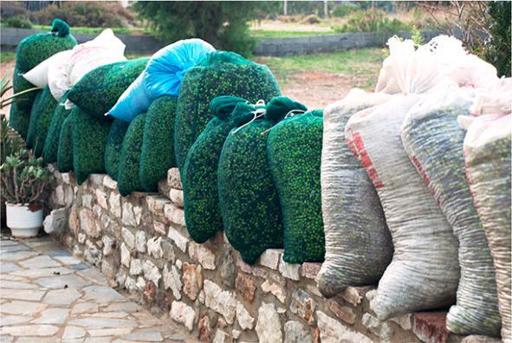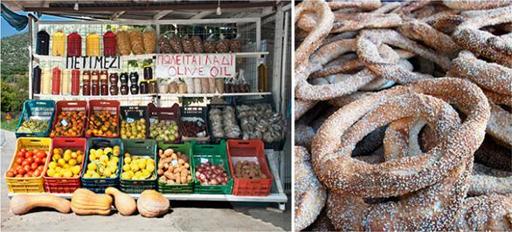Cooking Techniques With Olive Oil (2 page)
Read Cooking Techniques With Olive Oil Online
Authors: Mary Platis
Tags: #Cookbooks; Food & Wine, #Cooking Methods, #Regional & International, #European, #Mediterranean, #Culinary Arts & Techniques

Production of Olive Oil

In its simplest form, olive oil is produced by first grinding the olives into a paste. Next, the olive paste is pressed to extract the liquid, which consists of olive oil and water. Since oil and water have different densities, a centrifuge is used to quickly separate the two and prevent oxidation, which affects the flavor. Olive oil can also be produced by “cold-extraction,” which means that olive grinding is done at a temperature of no more than 77ºF (25ºC) to insure higher quality in taste, texture and aroma.
Extra virgin olive oils are the highest quality grade of olive oil. They must pass the standards of the industry and olive boards around the world. These standards and qualifications vary from country to country.

Varieties and Flavors of Olive Oil

The flavor of olive oil can change dramatically depending on the climate, soil conditions and the processing of the olives – resulting in the numerous varieties we have today. There are over 700 olive cultivars in the world, each of which produces one-of-a-kind flavor profile having unique nutritional and chemical properties.
As you cook and use olive oil daily, you will become more familiar with the many different varieties and their characteristics. Take a trip to a local olive grove for a tasting so you can determine which olive oil suits your taste.
As you begin to taste different varieties of olive oil, you will begin to notice slight to extreme differences in the flavors and bite. Think of it as you would wine varieties and how they vary. What determines these taste variations are the type of olives and how early or late in the harvest season they were pressed. Harvest begins in October and ends in February.
The olive changes color and flavor the longer it stays on the tree and begins to ripen. It starts out green, it moves to green-yellow, then changes to red, then purple, until it is (finally) very black. When the olives are harvested early in the season, in October, a greener more robust oil is produced. The taste is a more leafy green and leaves a burning sensation in the throat but has more healthful properties. Olives harvested later in January through February will be black and produce a milder oil.
Fragrant and fruity olive oil is typically from Spanish olives that are almost but not fully ripe. A greener and peppery taste comes from Tuscan-Style varieties. Leafy-green, grassy flavors develop mostly from Spanish and Greek olives pressed earlier in the year, which makes them strong and peppery. Whichever you decide on purchasing, enjoy olive oil liberally.

Listed below are just a few of the hundred different varieties of olives produced in the European and California regions.
- Greece: Koroneiki, Lianolia, Chrondrolia, Adramytini
- Spain: Picual, Arbequina, Hojiblanca, Manzanillo
- Italy: Frantoio, Leccnio, Pendolino, Moraiolo
- France: Picholine, Lucques, Bouteillan, Grossane
- California: Mission, Manzanillo, Arbosana, Arbequina
- Australia: Frantoio, Correggiola, Pendulina, Barouni
Selecting Olive Oil
Purchasing olive oil should be a simple and enjoyable trip down the shopping aisle. Buy olive oils in small bottles, as you begin your exploration, so you can experiment with many different oils. This is always wiser since olive oil has such a short shelf life, and it’s difficult to use up a large bottle within a year. Once you have made your selection, reach for the bottle in the back of the shelf, where it has been away from the sunlight. Extra virgin olive oil will last longer because it has a lower acidity level and this will buy you more time. Once you get it home place your olive oil in a cool dry place, and keep it away from any heat.
Here are some quick tips:
- Shop at a store you can trust that has hand-selected, fine quality olive oils.
- Buy olive oil with a harvest date stamp on the label to ensure freshness.
- Buy a small quantity, so you use up the oil within one year.
- Buy olive oil in a dark bottle for protection against sunlight.
- Do not choose an oil by its color. Instead, you should smell and taste it.

Storing Olive Oil
Olive oil contains a high monounsaturated fat content, which allows it to be stored longer than other oils. Store olive oil in a dark cool place in your kitchen, away from the stove or other heating elements to prolong its shelf life. Most experts recommend you store olive oil at room temperature, especially high-quality extra virgin olive oil. Olive oil kept in a dark environment can last up to one year opened, and up to two years if left unopened. Replace the bottle if it is not dark, and place it in a stainless steel container or a dark wine bottle.
Cooking with Olive Oil

Olive oil has been associated with the healthy Mediterranean diet and can be used in the kitchen in many ways, as we have outlined in this book. Having one or more olive oils from each of the three profiles below will encourage you as a cook to experiment and find new combinations of flavors for your dishes, such as cooking ethnic foods with the oils from that region.
Olive oils have varying characteristics and can be identified by using descriptive phrases similar to wines.
Robust flavor: Pungent, spicy, peppery (felt in the throat). Use strong and robust extra virgin olive oils for your meats to make marinades or to drizzle on peppers or garlic.
Medium flavor: Fruity, olive, green (grassy, leaves, apples, other fruit). Use a well-rounded extra virgin olive oil for breads, baking, steamed vegetables and dips.
Delicate flavor: Mild, buttery, sweet taste. This oil can be incorporated in cakes, cookies, and sauces.
The Mediterranean Diet

When people ask what the Mediterranean diet is, you must think “Olive Oil.” Along the Mediterranean Sea runs a long tradition of growing, producing, harvesting and cooking with olive oil. The Mediterranean diet is very popular as people seek more healthful ways of eating.
One important element of this diet, which most people are not familiar with, is the change of lifestyle that is often accompanied with the diet. A regular eating schedule is one important aspect to this lifestyle. This includes prepping, cooking, eating dinner together as a family, and enjoying each other’s company. Adding a glass of red wine to dinner is often the pleasurable choice of drink among the people of the Mediterranean, or one may drink tea. Staying active is another critical aspect of this culture that can improve longevity. It does not have to be strenuous exercise. It could be walking to local shopping areas or to work, gardening, involvement in a sport or attending community events. Having a belief system, whether it’s a religion or simply a gathering of like-minds, is also considered a factor in keeping your mind and body healthy and strong.

